The simplest do-it-yourself preparations: storing garlic in glass jars - life hacks and important rules
Garlic is not intended for long-term storage. After a couple of months, it begins to rot or mold, and if it survives until spring, it germinates or withers. But there is a wonderful way to store it - in glass jars. There are many options for such storage, we will consider all of them in this article.
The content of the article
Choosing garlic to store in jars
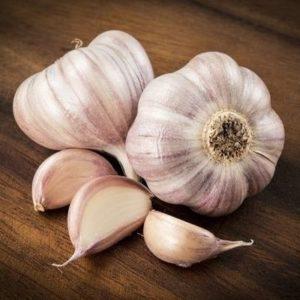 The first thing to do for better preservation of garlic throughout the year - is to dig it up in time. To do this, you need to know the ripening time of each individual variety. An overripe vegetable is more prone to rotting.
The first thing to do for better preservation of garlic throughout the year - is to dig it up in time. To do this, you need to know the ripening time of each individual variety. An overripe vegetable is more prone to rotting.
Another important factor - landing time. Garlic is either spring (planted in early spring) and winter (planted in autumn). The first one is harvested in August-September, the second - in late spring or June, depending on the variety.
The main sign of maturation - yellowing of the lower leaves, as well as cracking of the seed capsule on the arrow.
Find out! What can be planted after peas, and why is it so important change landing sites vegetables.
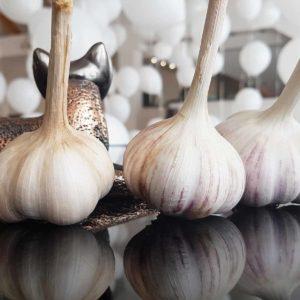 The best varieties of spring garlic for long-term storage:
The best varieties of spring garlic for long-term storage:
- Aleisky;
- Gulliver;
- Abrek;
- Sochi 56;
- Gafurian.
The best varieties of winter garlic:
- Alcor;
- Hermann;
- Reliable;
- Moscow region;
- Replicant.
In general, spring varieties tolerate long-term storage much better than winter varieties. They can remain fresh for up to two years.
Read in our article: what arepea varieties.
Storage preparation
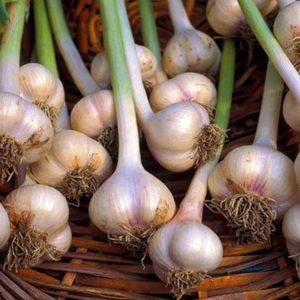 Dig up the garlic, leaving the stalks. They will be needed so that the head receives nutrients for some time. Then clean it with your hands from the ground and put it on the garden bed for 4-5 days.
Dig up the garlic, leaving the stalks. They will be needed so that the head receives nutrients for some time. Then clean it with your hands from the ground and put it on the garden bed for 4-5 days.
If the weather is rainy, it is better to remove the vegetable under a canopy or even indoors. If the weather is too hot and sunny, then the garlic will not like it either - burns are possible. Drying indoors takes 2-3 weeks. The scales will begin to flake off, become thinner and more transparent.
Next, the bulbs are cut from the stems and roots using a knife or secateurs. The stems are pruned to 3-5 cm, the roots - up to 3 mm.
To prevent the germination of the teeth, the roots of each head are scorched over an open fire.
If you did not harvest the crop on time, then in order to avoid the appearance of rot or mold, it is advisable to perform the following procedure:
- Heat 0.5 liters of sunflower oil.
- Add 10 drops of iodine to it.
- Mix everything.
- Dip the garlic heads into the mixture.
- Dry in the sun.
We figured out the choice of garlic and its preparation. Now let's move on to the question of how to store garlic in a jar.
Advantages and Disadvantages of Bank Storage
Like any other way of storing a vegetable, this option has its pros and cons.
The pluses include:
- The jar is an excellent barrier against microorganisms.
- It is convenient to store jars indoors, the product is packed rather compactly (under the table, in the closet, in the refrigerator, on the balcony - anywhere).
- You can use a variety of toppings and even create your own salad dressing.
- Garlic can be left unpeeled or peeled.
Minuses:
- Some of the jar storage options take a long time to prepare.
- Additional costs for fillers: salt, flour, oil, etc.
Preparing cans
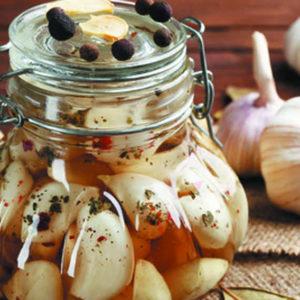 There are no difficulties at this stage - the jar just needs to be sterilized and dried... To do this, take a large saucepan or basin and boil the jars in it. If there are no large containers, then you can hold the jar over boiling water even in a small saucepan. Steam also kills germs.
There are no difficulties at this stage - the jar just needs to be sterilized and dried... To do this, take a large saucepan or basin and boil the jars in it. If there are no large containers, then you can hold the jar over boiling water even in a small saucepan. Steam also kills germs.
Another way is sterilization in the oven. Probably the most convenient. Firstly, the oven holds a large number of cans. Secondly, you do not need to figure out how to hold the can over the steam, so as not to burn yourself and not drop it.
Storage methods
There are many options for storing garlic. You can leave the vegetable intact, or you can disassemble it into heads or even grate it. Each case will have its own nuances. Let's consider each method in more detail.
Whole heads
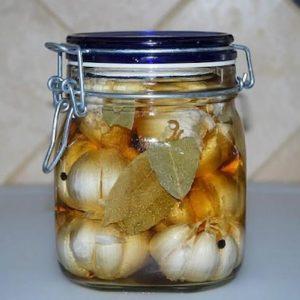 Peel the head from the top layer of husk and put in a jar. You do not need to fill it with anything and close the lid too.
Peel the head from the top layer of husk and put in a jar. You do not need to fill it with anything and close the lid too.
This is the fastest method, but it has two significant drawbacks:
- Whole heads leave a lot of empty, unused space.
- Rot can go unnoticed between the teeth.
Store in a cool but dry place.
Separate teeth
This method is similar to the previous one, as the vegetable is placed in a jar without any fillers. But in this case, the head is disassembled into teeth. It is very important to carefully examine each one for rot or mold. The container is stored in a dry place.
Dry
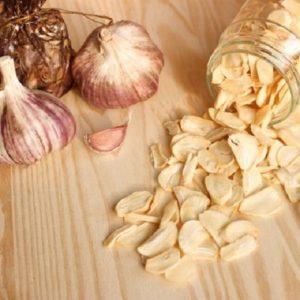 Disassemble the head into cloves and peel off. Cut each into thin circles. Dry. You get these kind of garlic chips. You can store both in jars and in bags. You don't need to close banks. These "chips" are added to soups and meat dishes. It is very convenient, and the taste and aroma are perfectly preserved.
Disassemble the head into cloves and peel off. Cut each into thin circles. Dry. You get these kind of garlic chips. You can store both in jars and in bags. You don't need to close banks. These "chips" are added to soups and meat dishes. It is very convenient, and the taste and aroma are perfectly preserved.
Dried slices can be chopped in any convenient way and used as a fine seasoning, the so-called garlic salt.
Storage in flour
In this case, flour is poured onto the bottom of the jar with a layer of about 2 cm, then garlic is spread, and flour is sprinkled on top again. So it is necessary to repeat the layers to the neck. You can use both whole heads and teeth (only you do not need to clean them). Flour serves as an insulator here: it prevents the heads or teeth from touching each other and absorbs excess moisture.
In salt
Storing garlic in glass jars with salt is an alternative to storing it in flour. Salt also acts as an insulator here. The jar is left open. Both heads and tines can also be stored in salt. The prongs can also be stored peeled. Salt disinfects and allows the vegetable to be stored all winter and even spring.
In ash
Wood ash can be used instead of flour and salt. But in this case, you only need a couple of tablespoons. Sprinkle the garlic with the first spoon, filling the container halfway, the second at the end.
In vegetable oil
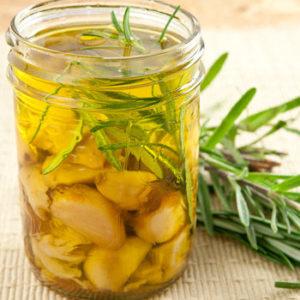 Quite a sophisticated method. Put the peeled and washed garlic cloves in a jar and pour over with vegetable oil. In this case, you can use both sunflower and other oils, for example, olive, linseed. And someone uses unrefined sunflower oil - it all depends on your personal taste preferences.
Quite a sophisticated method. Put the peeled and washed garlic cloves in a jar and pour over with vegetable oil. In this case, you can use both sunflower and other oils, for example, olive, linseed. And someone uses unrefined sunflower oil - it all depends on your personal taste preferences.
Add spicy dried herbs, peppers or other spices if desired. Remove the garlic cloves as needed. The oil itself can and even should be used. It acquires a piquant taste and aroma. This oil is perfect for salad dressing.
The method has a significant disadvantage - garlic loses some of its nutrients.
Find out from our article: beans are protein or carbohydrates? Understand the composition and properties of the product.
Store in a closed jar. The shelf life of such a product is about 4-5 months.
In wine
Marinated garlic in wine belongs to the Mediterranean cuisine. You can pour the peeled wedges in a jar, or put them in a bottle of wine (with a wide neck). The type of wine does not matter, here, again, it all depends on your taste. You can use dry, red or white.
An alternative is storage in vinegar. But it should be borne in mind that the taste of garlic will be completely different.
Shabby
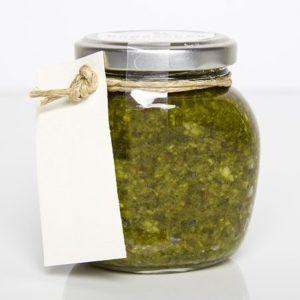 This storage method is more like a prepared gravy, rather than a way to store garlic as raw material. But, nevertheless, a great option.
This storage method is more like a prepared gravy, rather than a way to store garlic as raw material. But, nevertheless, a great option.
The garlic must be divided into slices, peeled and rinsed. Then chop in a blender or grate. Put the resulting mass in a jar and fill with oil. Stir the contents until smooth. In this case, you do not need to pour much oil - about 1.5 times the volume of grated garlic.
Any oil will do. For spice, you can use olive oil and add dried Provencal herbs. It will make an excellent dressing for meat and vegetable dishes.
Also you can find out the top 20 best ways marinate garlic at home.
Where to store banks
Ideal storage space is in the refrigerator or cellar. But there is often not enough space in the refrigerator, and housewives store garlic just in the house or on the balcony.
The main thing is not to place the container in the sun, near a battery or in a damp place. Without refrigeration, shelf life is slightly reduced. But at the same time, the temperature should not fall below 0 degrees, otherwise the garlic will freeze.
Shelf life
The shelf life of garlic directly depends on the method and location of its storage. It is stored in oil for about 4 months. Wine and vinegar are added to the shelf life for about 4 more months - it turns out more than six months.
As for dry storage, if all conditions are met, garlic will be preserved until spring in any filling: and in salt and flour.
Tips & Tricks
Here are some tips to help keep your vegetable fresh throughout the winter:
- spring garlic is stored at 16-20 degrees and humidity 50-70%;
- winter - at 2-4 degrees and humidity 70-80%;
- damaged teeth are used immediately, without leaving for the winter;
- it is advisable to store garlic separately from other vegetables.
Read in the following article: how often water tomatoes in the heatto get a good harvest.
Conclusion
In whatever container and with whatever filling you store the vegetable, from time to time it must be examined for the appearance of darkening. If you find them, remove the damaged head or clove so that the rest do not get infected. And it is better at the very beginning not to regret and not to leave for storage the slices that cause you doubts. It is better to eat them right away than to go through the whole jar and lose some of the harvest.
The methods and techniques given in the article will help to extend the shelf life of garlic, as well as add variety to your menu using this useful and valuable product.